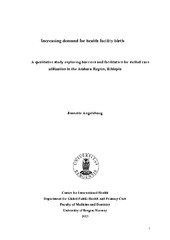| dc.description.abstract | The current study aims to explore women’s and health workers experiences and perceptions on barriers and facilitators for health facility delivery in Northern Ethiopia. Ethiopia has one of the highest maternal mortality rates in the world and few women give birth in a health facility. The World Health Organization states that the most efficient strategy to reduce maternal mortality is to secure skilled attendance at birth, which involves the assistance of skilled health workers in an enabling environment with possibilities of referral. The Ethiopian government has adopted this strategy. The factors associated with use of health facilities for birth are well known, but there is limited research on why women seek health facility for their delivery and what is required to increase the demand for health facility delivery. The study was conducted in North Gondar zone in the Amhara region in Ethiopia in 2012 and used a qualitative approach. 29 participants from rural, semi-urban and urban settings were recruited. The sample included women with experience of health facility birth, women without experience of health facility birth, one husband, and health workers working in delivery wards in two health centres and one hospital. The data were collected through indepth interviews in community and health facility settings, and non-participant observation in the hospital labour ward. The Availability, Accessibility, Acceptability and Quality (AAAQ) framework were drawn upon in the analysis of the data combined with the concepts of trust, security and authoritative knowledge. “Thematic Content Analysis” was applied as a procedural guideline. The findings confirm that distance to the health facility, access to transport and unpredictable cost are major barriers for health facility birth. The study also found that acceptability of health facility delivery in terms of respectful attitudes, having privacy and support, and quality of care related to medical safety, may be as essential to improve as the issues regarding availability and accessibility in order to increase the demand for health facility birth. Availability and accessibility was naturally a larger barrier for use of birth services in rural areas. The acceptability of birth services seemed to vary with the location, but the perception of health workers as impolite and unsupportive dominated our findings. The AAAQ framework was essential to identify the barriers and facilitators for health facility birth from a health system perspective. Social and cultural context related to childbirth were introduced to address additional factors. Who was trusted as a birth attendant was closely associated with who women saw as having ‘the authoritative knowledge of birth’ and the appropriate place to give birth seemed to be linked to concerns about feeling secure in both medical and social terms. This varied in the rural, semi-urban and urban settings and produced patterns in perceptions about ‘the appropriate place to give birth’. For women in the urban area, the health facility was generally perceived to be the appropriate place to give birth, while women in rural areas considered home as the appropriate place to give birth. Women in semiurban settings differed in their perceptions on the appropriate place to give birth. Based on the study findings I conclude that in order to increase demand for health facility delivery, one needs to address not only availability and accessibility issues which have been high on the Ethiopian health policy agenda recently, but also issues related to acceptability and quality of care. The social and cultural context also has to be taken into consideration because one needs to understand why the women choose their home before the health facility to give birth. The thesis is based on the current guidelines provided by the Centre for International Health, University of Bergen. The chosen format is a monograph. | en_US |
